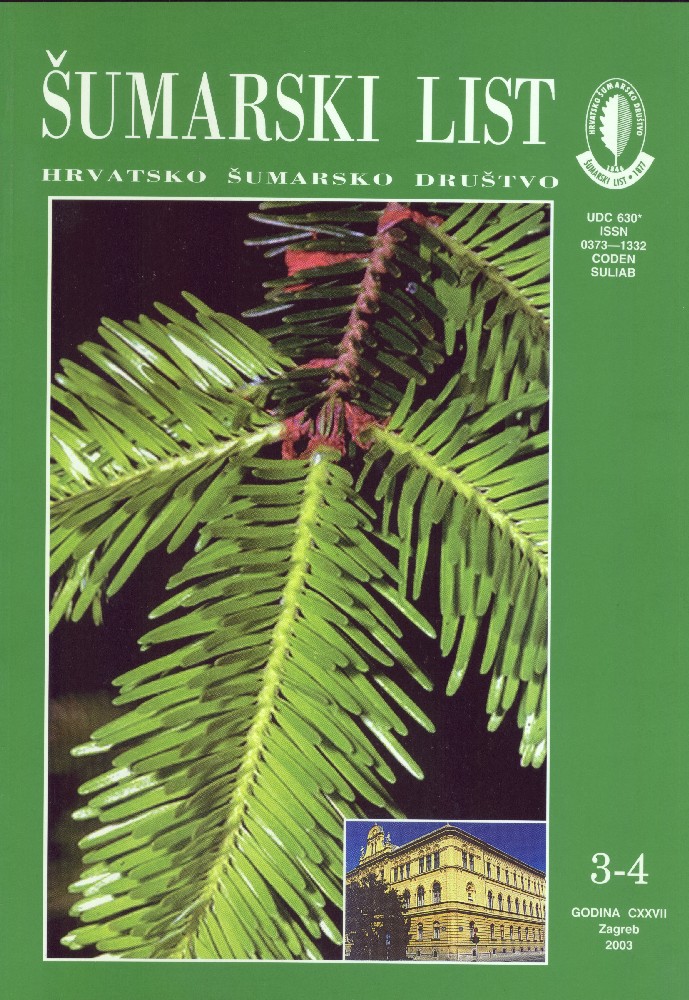
broj: 3-4/2003
pdf (28,3 MB) |
|
||||||||||||||
| IZVORNI ZNANSTVENI ČLANCI | ||
| Margaletić, J., Glavaš, M., Pavić, K. | UDK 630* 451 (001) | |
| The Numerousness of Small Rodents and their Harmfulness in the Management Unit of “Južna Krndija I (Kutjevačka)” and in the Nursery “Hajderovac”. pdf HR EN | 99 | |
| Križanec, R. | UDK 630* 612 + 613 (001) | |
| New Variants of Time Management of Selection Forests pdf HR EN | 109 | |
| Ballian, D. | UDK 630* 165 (001) | |
| Estimate of the Genetic Variability of Silver Fir (Abies alba Mill.) by Analysis of Isoenzymes in the Part of Natural Populations of Bosnia and Hercegovina and Croatia pdf HR EN | 135 | |
| Summary: The research was used to establish molecular genetic variability of some populations of silver fir in Croatia and Bosnia and Herzegovina (Vranica, Meka Brda, Gorski Kotar - adult, Gorski Kotar - juvenile, Crni Vrh, Čabulja, Biokovo, Orjen) using the analysis of isoenzymes. Apart from large populations such as the ones from Vranica, Meka Brda, Gorski Kotar - adult, Gorski Kotar - juvenile, the focus of the research was on smaller populations from the sub-Mediterranean areas (Biokovo, Orjen), so that their relationship with the populations from the central part of natural ranges from Croatia and Bosnia and Herzegovina could be established. One population from the Pannonian population (Crni Vrh) was also studied. The above research is also important as it points to future work of re-establishing silver fir forests (replanting and seed sowing) and setting up banks and gene archives using both in situ and ex situ methods. The analysis of isoenzymes, the level of heterozygote (He) and multi-locus differences (Vgen) show that there are differences between the studied populations, particularly those between small isolated populations and large populations. By analysing 16 isoenzyme locus genes, the existence of statistically important differences between the studied populations have been established. Cline variability was also found for the silver fir. It has been established that gene loci Pgi-A, Got-A, Sdh-A are characteristic for the silver fir from the Balkan area while gene loci Fest-A are characteristic for southern Italy or central European area. The higher value of heterozygotes of the studied populations compared to the populations of silver fir in Western Europe shows that the studied populations have not lost much of their genetic potential to adaptability, as they are not far removed from their glacial refuge. This seems to be due to the fact that these populations are sturdier than the populations of Western Europe as they posses enough genetic variability. In order to maintain genetic resources, a better network of gene banks both in situ and ex situ should be established. This means that each ecological niche important for silver fir should have its own gene bank with a responding number of units so that ecological-physiological traits could be preserved. With regard to management and regeneration of natural resources, natural methods combined with constant monitoring of genetic structures and differences should always be favoured. Measures should be undertaken to preserve the genetic variability that characterises each population. Future research should focus on other populations of silver fir in Croatia and Bosnia and Herzegovina, and an optimal number of units should be set up per sample. Management practices should be constantly monitored and directed at maintaining the genetic differences of local populations. Moreover, extensive experiments should be carried out to study eco-physiological characteristics of silver fir. The used methods provide a good picture of the genetic structure of the populations, the basis of which could serve to determine measures to be undertaken in order to preserve the genetic resources of the studied populations as compared to the results obtained from morphometric research. | ||
| PREGLEDNI ČLANCI | ||
| Vojniković, S. | UDK 630* 188 | |
| The History and Recent Problems of the Phytocoenological Nomenclature and Classification pdf HR EN | 153 | |
| STRUČNI ČLANCI | ||
| Margaletić, M. | UDK 630* 931 + 891 | |
| The Exploitation of Mineral Raw Materials in Relation to the Forest and Forest Land pdf HR EN | 161 | |
| Nodilo, J. | UDK 630* 432 | |
| Fire in the Open Space of the Islands and Littoral - Accident or a Logical Sequence of Events pdf HR EN | 171 | |


